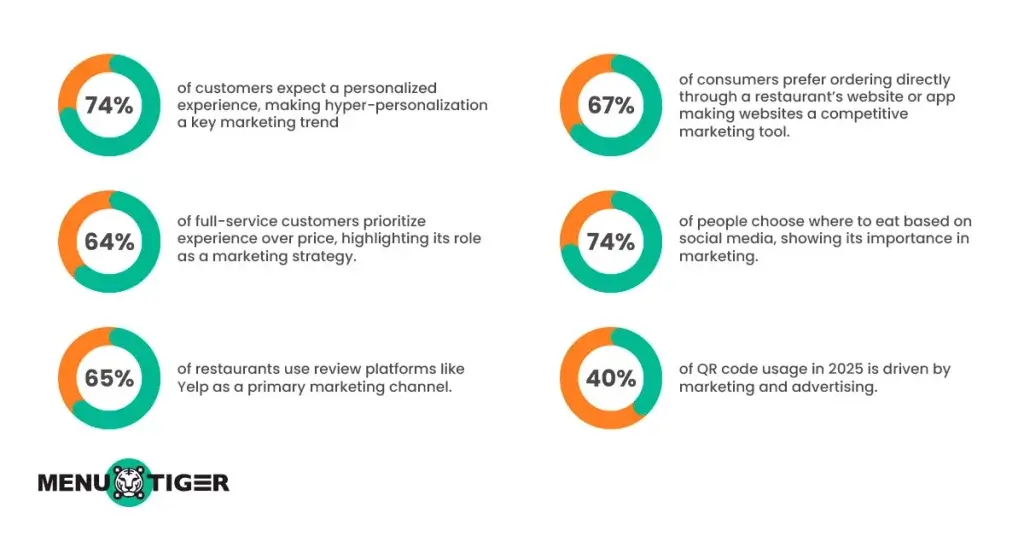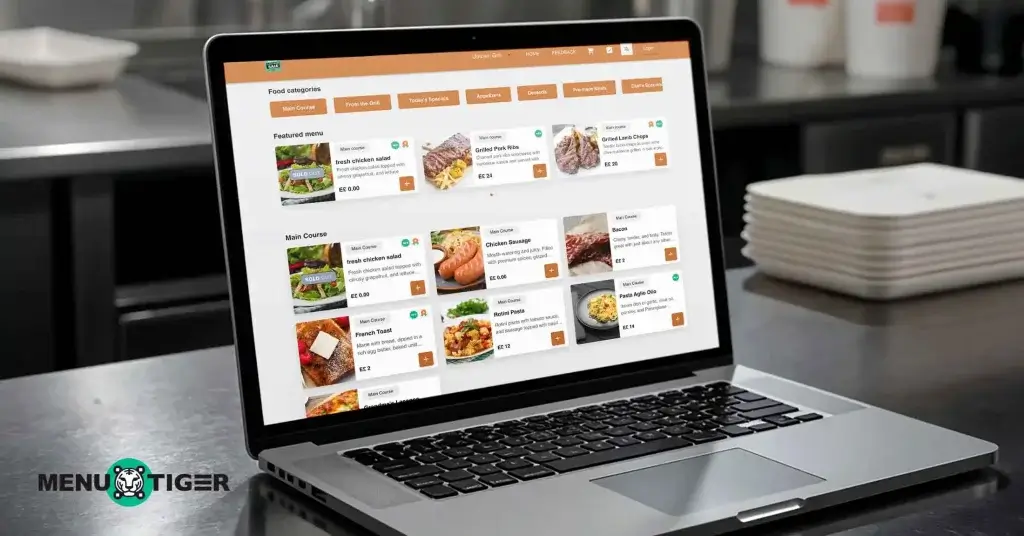In the 2025 restaurant landscape, just being good isn’t enough. Audiences are divided. Some respond to digital marketing while others prefer traditional methods, and standing out has never been more challenging.
With millions of restaurants running their own marketing campaigns, how will yours stand out and capture attention? Social media might help, but there is something even more powerful.
The Peak-End Rule, a concept introduced by psychologist Daniel Kahneman, suggests that people remember experiences based on the most intense moments and how they end, leaving a lasting impression.
This is the essence of “Unreasonable” marketing, the strategy behind the success of Eleven Madison Park, the world’s number restaurant, which goes beyond ordinary hospitality to create unforgettable experiences.
In this article, discover how they put this transformative restaurant marketing strategy into action.
Table of Contents
Toggle2025 restaurant marketing trends

According to various research studies, these are the main marketing trends for 2025:
- Hyper-personalization. According to Accio, 74% of customers expect a personalized experience, making hyper-personalization a key marketing trend.
- Experience-driven dining. The same source reports that 64% of full-service customers prioritize experience over price, highlighting its role as a marketing strategy.
- Review sites as marketing tools. A 2025 WifiTalents report shows that 65% of restaurants use review platforms like Yelp as a primary marketing channel.
- Restaurant websites/apps. CSP Digital states that 67% of consumers prefer ordering directly through a restaurant’s website or app rather than third-party platforms, making websites a competitive marketing tool.
- Restaurant social media marketing. Up to 74% of people choose where to eat based on social media, showing its importance in marketing.
- QR codes in marketing. According to QR‑Insights, 40% of QR code usage in 2025 is driven by marketing and advertising.

How the world’s #1 restaurant gets free marketing: 10 lessons you need to know

Will Guidara, co-owner of Eleven Madison Park, which earned the number one spot on The World’s 50 Best Restaurants list in 2017, focuses on providing hospitality that goes beyond expected standards.
Their marketing approach is not about persuading people traditionally through restaurant digital marketing on social media, paid ads, posts, or a rewards system.
Instead, they focus on marketing within the restaurant itself, tapping into the emotional experiences of customers.
This approach naturally motivates guests to promote the restaurant on their own behalf, whether through word of mouth, online reviews, or other forms of customer-driven marketing.
Here is how they do it:
1. Challenge the norm
The key to staying top-of-mind with your customers is to give them the best possible experiential dining in your restaurant.
Take Dinner in the Sky, for example. Diners are lifted 150 feet above the ground, which creates a cloud-level experience.
They went viral online, gaining massive public attention simply because customers shared their unforgettable experience.
2. Ask for reviews
One major advantage of free marketing is that it is often more reliable and credible than promoting your restaurant yourself.
Social media marketing statistics 2025 show that 63.9% of users worldwide are on social media, making user-generated content a valuable advantage.
So, politely encourage guests to leave feedback on Google, Facebook, or food delivery apps.
People trust real customer experiences more than advertisements, and a single positive review can attract new diners.
3. Take calculated risks (95:5 rule)
The 95:5 rule states that you should manage 95% of your profits effectively, allowing the remaining 5% to be allocated to delighting customers. It could be a golden spoon, a fireworks display for your outdoor dining, or anything unexpected that leaves a lasting impression.
That 5% is what often inspires photos, videos, and online mentions, which helps you stand out on social media for restaurants today.
4. Be restaurant-smart
Restaurant-smart strategies focus on quality service and details that make meals Instagram-worthy, which in turn sparks word-of-mouth marketing and encourages customers to share their experience on social media.
A unique presentation, creative plating, or an unexpected touch can motivate diners to post photos online, exposing your restaurant to a wider audience at no additional cost.
5. Practice reverse benchmarking
Instead of copying what customers love about your competitors’ products, focus on what they don’t do well and turn that into something people will remember and talk about.
All fast-food chains offer a similar concept of food, but they stand out in their own way.
Take Jollibee as an example. Despite fried chicken being the core dish of most fast-food chains, their fried chicken gained attention online, was hailed as the best, and the curiosity it sparked among people around the world helped the brand grow globally.
6. Solve customers’ pain points
If you want customers to engage in digital marketing for restaurants without being asked or paid, focus on providing them with the best comfort by addressing their pain points.
For example, a fragmented waitlist system can really make you lose potential customers. If you are going to address it, do it smartly and creatively.
Let customers scan a QR code to join a virtual queue where they can see their position in line and receive SMS updates.
This reduces crowding and gives them the freedom to walk around instead of standing and waiting.
7. Embrace conflicting goals
If you are a quick service restaurant and offer classics like burgers, fries, and dogs, and buns, that doesn’t mean you should stick with being casual.
Present it in a fine dining setting and make it Instagrammable, allowing customers to take pictures and market it for you.
8. Hire the right people

You can train skills, but you can’t train attitude. Make your staff your brand ambassador. Hire for genuine kindness, warmth, and a caring personality.
Staff who are naturally hospitable and passionate about making people happy will treat every customer interaction as an opportunity to create a memorable moment.
9. Put hospitality first
When you focus on genuine hospitality, you may not even need a marketing plan; your service itself becomes the promotion.
Remember that service is technical (getting the order right), but hospitality is emotional (making the guest feel cared for). Hospitality means being intuitive, anticipating needs before they are voiced, and finding ways to say “yes.”
When you genuinely make a guest feel valued and important, they become your most enthusiastic promoter.
10. Do it how customers want it
You know the saying, “customers are always right.” It is true, but at the same time, you should not lose your credibility as a chef or restaurant owner.
If a guest orders a medium rare steak and you cooked it correctly, yet they say it is wrong, you can reply politely: “This is the standard for medium rare, but I can adjust it for you. Would you like it cooked a little more?”
As much as possible, avoid arguments because when guests feel respected, they are more likely to return and recommend your restaurant. This simple act supports organic marketing and strengthens your reputation.
Why order management systems are the ultimate must-have restaurant marketing tool

The restaurant ordering system has evolved into far more than just a tool for taking orders. This system is adapting to the rise of digital and service-oriented marketing, enabling restaurant owners and staff to deliver an exceptional customer experience.
Here’s how this smart tool can assist your marketing efforts:
1. Offers a basic restaurant website
Restaurant websites are valuable, as research shows that people are most likely to visit online pages, such as websites and social media, before ordering or visiting a restaurant.
A smart menu management system enables you to create a website that showcases your restaurant’s background.
It also enables customers to place orders directly from your site, not just view it. This way, you can highlight your menu, feature bestsellers and new dishes, and include mouth-watering descriptions to entice customers.
2. Collects customers information
If a customer logs in to your restaurant website to place an order, you can collect their contact information, such as email, address, name, phone numbers, and other relevant details. The restaurant order system allows you to personalize offers and send updates to your customers about your events, new specials, discounts, and more.
3. Consolidates measurable data
If you manage multiple stores, this feature is especially useful. Smart order systems allow you to handle multiple locations within a single system.
The smart part is that you can consolidate data from each store and track what the best sellers are in specific locations.
In this way, you can tailor your restaurant marketing ideas and target specific geographic areas.
4. Creates a digital survey form
Through this feature, you can collect insights from your customers and turn them into actionable data.
In addition, you can design surveys that allow customers to provide feedback on the food, service, and overall experience.
This way, you can generate customer-generated content that boosts credibility and builds trust with potential customers.
5. Supports service-type marketing
A restaurant waiter call button is a feature that allows customers to call for assistance without shouting, standing up, or raising their hands. With just one tap, staff are alerted to the customer’s request.
There is no need to monitor them too closely, which might make them feel uncomfortable, especially if they are dining to unwind and need some space.
So, look for a system that includes a restaurant waiter call button so you can market through a service-based strategy where offering a memorable experience helps increase foot traffic and repeat visits.

Create memorable moments and watch the buzz grow!
We’ve covered a lot of ground, from the rising demands of restaurant marketing ideas in 2025 to the tactical power of a smart restaurant ordering system in managing data and pain points.
But the ten lessons from the world’s number one restaurant all point back to one, game-changing philosophy: Hospitality is your best marketing plan.
Will Guidara didn’t chase trends; he focused on creating what psychologist Daniel Kahneman calls the Peak-End Rule: those intense, unforgettable moments and a perfect conclusion that stay with the guest long after they’ve left.
So, here is your final takeaway: focus on being ‘unreasonable’ in your dedication to delight, and watch as your most enthusiastic free marketing team, your happy guests, takes over the rest.



